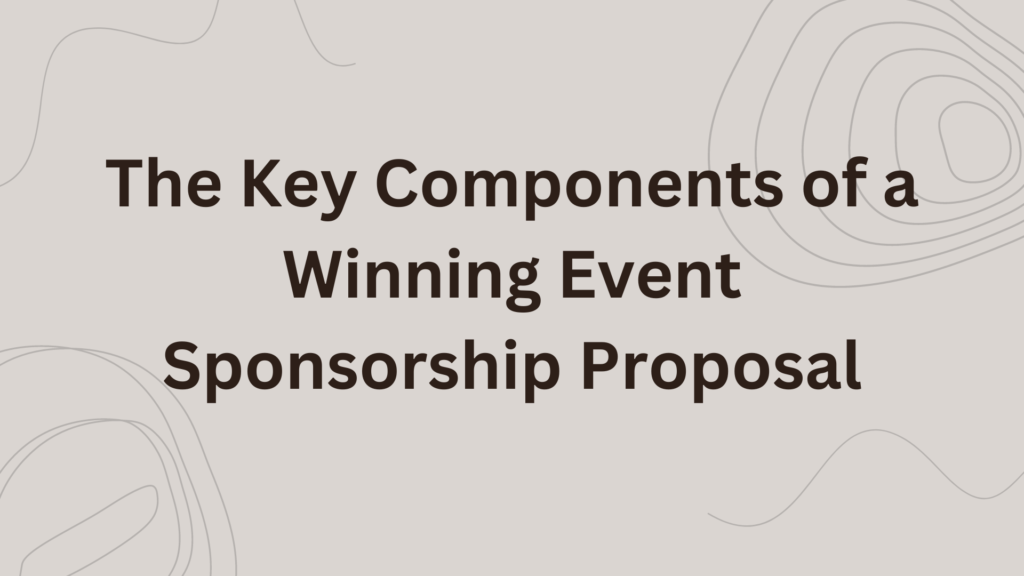
Table of Contents
ToggleThe Key Components of a Winning Event Sponsorship Proposal
Creating an effective event sponsorship proposal can be a game changer for your event’s success. Whether you’re planning a large conference, a local festival, or a charity run, the right proposal can attract sponsors who align with your vision and goals. In this blog, we will explore the key components of a winning event sponsorship proposal and how to ensure it stands out.
Why a Strong Sponsorship Proposal Matters
A well-crafted sponsorship proposal acts as a roadmap for potential sponsors, clearly outlining the benefits of supporting your event. With the right approach, you can demonstrate how their involvement can enhance their brand visibility and engage their target audience.
Key Components of an Event Sponsorship Proposal
Here’s a breakdown of the essential elements your proposal should include:
| Component | Description |
|---|---|
| 1. Executive Summary | A brief overview of your event, its purpose, and why it matters. |
| 2. Event Details | Key information about the event: date, location, audience demographics, and expected attendance. |
| 3. Sponsorship Levels | Clearly defined sponsorship packages, including benefits for each level. |
| 4. Marketing Strategy | How you plan to promote the event and sponsors through various channels. |
| 5. ROI for Sponsors | Quantifiable metrics showing potential returns for the sponsors (e.g., exposure, audience engagement). |
| 6. Call to Action | A strong invitation for potential sponsors to get involved, with contact information. |

1. Executive Summary
Start with an engaging executive summary. This section should be concise, offering a snapshot of what the event is about and the impact it aims to achieve. Use long-tail keywords like “event sponsorship opportunities” and “benefits of sponsoring an event” to capture interest.
2. Event Details
Provide detailed information about your event. This includes the date, location, and target audience. Highlight the expected attendance numbers and demographics, using phrases like “target audience for event sponsorship” and “event participation statistics.” This information is crucial for potential sponsors to gauge the reach of their investment.
3. Sponsorship Levels
Define your sponsorship packages clearly. For example:
- Gold Sponsor: $10,000 – Includes premium logo placement, a speaking opportunity, and social media mentions.
- Silver Sponsor: $5,000 – Includes logo placement and promotional materials.
- Bronze Sponsor: $2,500 – Includes logo placement on the event website.
Total Money Makeover: Classic Edition
4. Marketing Strategy
Outline your marketing strategy to promote the event and sponsors. Include digital marketing tactics like social media campaigns, email newsletters, and partnerships with local influencers. Use phrases like “event marketing strategies” and “how to promote event sponsors” for better search visibility.
5. ROI for Sponsors
Demonstrating return on investment (ROI) is crucial. Share projected metrics, such as:
- Brand Exposure: Estimated impressions across various channels.
- Engagement Rates: Anticipated interactions with the audience.
- Post-Event Reports: Information on how you will provide sponsors with data on their sponsorship impact.
6. Call to Action
End your proposal with a compelling call to action. Invite potential sponsors to reach out for further discussions. Provide your contact information and encourage them to act quickly to secure their involvement.
Beach Money: Creating Your Dream Life Through Network Marketing
Conclusion
Creating a winning event sponsorship proposal involves clear communication of the value you offer to sponsors. By including the key components outlined above and using effective long-tail keywords, you can craft a proposal that not only attracts sponsors but also ensures mutual success.
Remember, a well-structured proposal is your chance to make a lasting impression. Use this opportunity to highlight how partnering with your event can help sponsors achieve their marketing goals.
FAQs About Event Sponsorship Proposals
What is an event sponsorship proposal? An event sponsorship proposal is a formal document that outlines the details of an event and invites businesses or organizations to financially support it. It typically includes information about the event’s purpose, target audience, benefits for sponsors, and the different sponsorship levels available.
How do I attract sponsors for my events? To attract sponsors, consider the following strategies:
- Create a Compelling Proposal: Clearly outline the benefits sponsors will receive, such as brand visibility and audience engagement.
- Research Potential Sponsors: Identify companies that align with your event’s theme or target audience.
- Offer Various Sponsorship Levels: Provide different options (e.g., gold, silver, bronze) to accommodate various budgets.
- Showcase Past Success: If you have held similar events, share metrics and testimonials to build trust.
- Network Effectively: Attend industry-related events to make personal connections with potential sponsors.
Do you need a premium sponsorship proposal format? While a premium format can enhance the visual appeal of your proposal, the content is the most critical aspect. A clear, organized proposal that effectively communicates the benefits of sponsorship is essential. Use headings, bullet points, and visuals to improve readability, but you don’t necessarily need a costly template.
What are the different types of sponsorship proposals? There are several types of sponsorship proposals, including:
- Title Sponsorship: The sponsor’s name is prominently featured as the main supporter of the event.
- Gold, Silver, and Bronze Sponsorships: Different tiers of sponsorship offering varying levels of benefits based on contribution amounts.
- In-Kind Sponsorship: Sponsors provide goods or services (such as food, venues, or marketing support) instead of cash.
- Media Sponsorship: Media outlets promote the event in exchange for branding opportunities and exposure.


